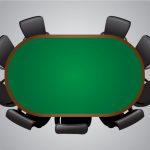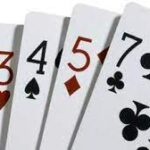This is part 2 in a 2 part series. Make sure to check out Part I before reading this – No Deposit – All Returns: How to Build a Bankroll from Nothing Part I
Freeroll Strategies
Whether you are playing the freerolls at FullTilt or PokerStars you have to be good to win. By playing frequently and studying poker strategy, a serious player can chart their progress. A simple piece of paper and a pencil will keep track of your finishing position and is one sure way to know how you are improving over time. When you start to consistently finish in the top 10% of the freerolls you can begin to see the prospect of hitting the money.
One of the most important things to realize in dealing with these freerolls is that the opposing players behave in a different manner than in most other situations. You can see this by sitting out and watching what happens as the freerolls progress. Because they have no real money at stake, a great number of players will imitate what they see on TV and go “All-in” constantly. Early on, bluffers abound. Within ten minutes of the first deal, usually 10% of the field has been eliminated. Within half an hour half the field is gone. With these multi-table tournaments, the name of the game is survival and sitting out the first fifteen minutes usually does you no harm. Playing tight early is important for long term survival.
Understanding the mathematics is also an important tool in surviving in the freerolls. Print up a chart of drawing odds and keep it handy (maybe tape it to your screen). Understanding position betting and pot odds help in making call or fold decisions.
When you are well established in a freeroll, with a good chip cushion and a narrowing field, keep an eye on the mathematical chip target needed to finish above the bubble. For example, in a Full Tilt $100 Freeroll there are 2700 players and each starts with 1500 chips. That makes a total pool of 4,050,000 chips in play. If only 27 players are going to get cash, then the average chip count a player needs to cash in is 4,050,000/27 = 150,000. Since that is the average number, half will be above it and half below. So if you get anywhere near 100,000 chips you should consider sitting out. Sitting out may not be exciting or glamorous, but the point is to get free cash into your bankroll.
Winning cash in freerolls is very difficult, but the fact is that if you can’t win at the freerolls, you will never be a winner at the cash games. Suckers (god bless them) can’t imagine grinding it out for micro-stakes and seek the adrenaline rush of betting hard cash. They can’t be bothered to do the math and endure the agony of considering poker as a real job. Those are the people who will fill your bankroll at the cash games.
Building Your Bankroll
Once you have won some real money at a freeroll, you will lose it immediately by playing cash games unless you recognize the need to change strategies. The opponents play differently and you have to adjust quickly or your funds will disappear.
The key to building a bankroll in cash games with that initial freeroll seed money is to play very tight at first. Choice of game is critical and choice of table within that game is equally important. Cash games are markedly different from freerolls and each variety of cash game has its own peculiarities. Cash ring games require a unique strategy for each stakes level, as micro .01-.02 Fixed-limit Hold’em is different than .01-.02 No-limit Hold’em and totally different than .05-.10 Pot-limit Omaha.
The best chances of holding on to what you have and adding to it are at micro-stakes Fixed-limit Hold’em. A 10-seat ring game gives plenty of hands with no blinds draining away your precious few cents. Spot the loose players that call every blind. When in doubt, fold.
Stay away from micro-stakes Sit and Goes because the return on the investment is poor even if you win.
No-limit and Pot-limit Hold’em are dangerous for the small bankroll player as it is easy to get drawn into a hand that sucks out a lot of chips. Unlike freerolls, going all-in at a cash ring game is a good way to lose your bankroll and ruin your day.
Stick with the micro-stakes and build up the bankroll before moving up to the next level of stakes. It’s awfully easy to lose a month’s work in a few minutes by jumping into a mid-stakes game which you are unprepared for.
Building up a bankroll from nothing is a grind. There’s no other way to put it or to do it. It’s like the Olympics marathon. You can’t just start running one day and expect to win the race the next. You have to train and train and train, stepping up the distance and the speed over the long run.
When you have accumulated a modest sum through the fixed-limit grind, the next logical move is to the micro-stakes no-limit. The strategy must still be to play tight. You must walk away from all-ins and big raises unless you are certain that there is no chance of being beaten. Folding to the all-in dares of Matusow-wannabees and the rabid raises of ersatz-Prahlad-Friedmans may be damaging to the ego, but keep focused on bankroll building – that’s the goal.
Study the tables before you join one. Understand the lobby statistics for the tables. A lot of small bankroll players will look at the room lobby and seek a table where a high percentage of the players see the flop and the average pot size is large. Unfortunately, for them, that is a table where they can easily lose their cash fast. A high percentage of players seeing the flop means better odds for a bad hand to draw into a winning hand. For the player looking to build up their bankroll, it’s better to find a table with a small percentage seeing the flop and a small pot size. At a micro-stakes no-limit table that’s a sure sign that most players are timid and folding. The pot never gets large because nobody calls the big blind unless they have a high pair. A savvy player can swoop in, position bet and steal the pots because the others are afraid to call a raise.
If you are at a table and the cards you are getting dealt are bad, leave the table. Go somewhere else. Understand that in the great mathematical world of combinations, of a million poker players dealt a million hands of poker, everyone will have a similar number of winners and losers. However, for each player there will be times during which the majority of dealt hands will be winners (being “in the zone” as they say) and another long series where the majority will be losers (“no playable hands all day”). Learn to recognize where you are at and play accordingly. If you are having a bad day, go away and come back tomorrow. Or consider switching to Razz to take advantage of your bad luck!
With a sufficient bankroll cushion you can enter small stakes cash MTTs that offer a good multiplier on the investment for the places paid. Target the special larger guaranteed prize pool tourneys (usually on Saturday and Sunday) which can give more bang for the buck. Read the tournament rules carefully and if, for example, there are re-buys and registration stays open for the first hour, enter it late. The reason is that bigger bankrolls will play looser in the beginning when the re-buy option is open and will be more likely to try to bluff out a winning hand with a big bet. When the re-buy window closes, the big bluff betting goes down considerably.
As your bankroll slowly grows, the temptation will be to move up to higher stakes. Do it only when you have a bankroll of at least 50 times the big blind. Opposing players will play differently at higher stakes and observing the tables before joining is even more important. Be prepared to take a hit to your bankroll when moving up and set a stop-loss limit of say 20% of your accumulated bankroll. If you lose 20% go back to playing at the lower stakes until you have replenished that capital. Don’t make the common gambler’s mistake of betting more to recapture what you have lost. Don’t let your ego rule. Take your loss as a lesson that you haven’t mastered the game well enough to win at the higher level. If you are losing then you are playing too loose and making mistakes. Get away from that table and fast! Conserve your hard earned cash and change strategies. Go back to the lower stakes and grind it out again.
Building up a bankroll from nothing is not easy, but it is possible. Doing it makes you a better player. Each victory is sweeter and each loss is more painful. Using each loss as a lesson will make you a formidable poker opponent. Building a bankroll from nothing will ultimately give you a bankroll to brag about.
Best of luck!
Submit your review | |










